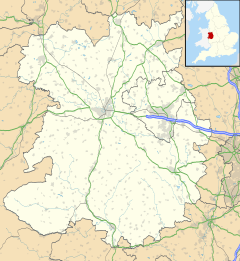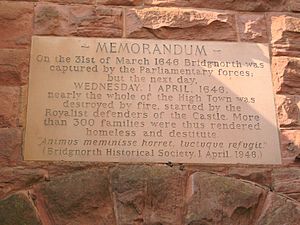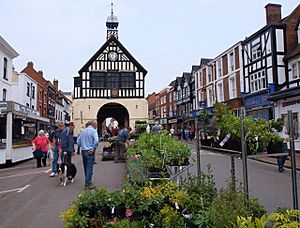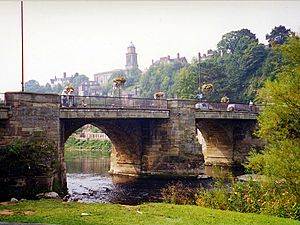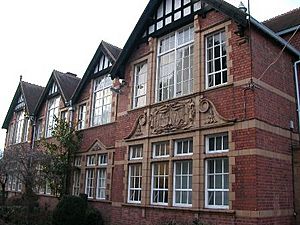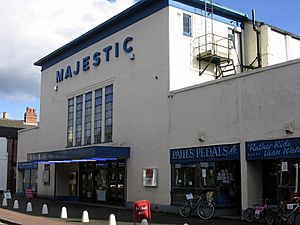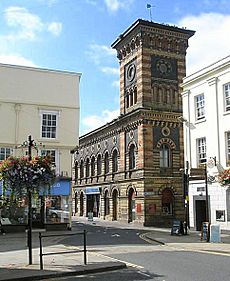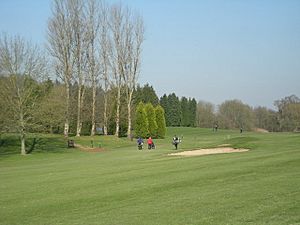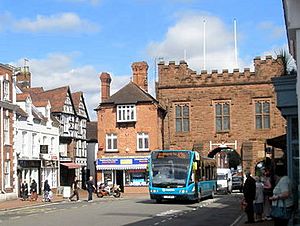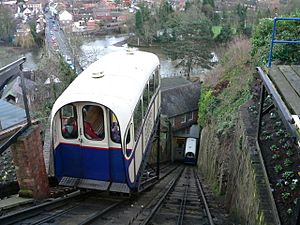Bridgnorth facts for kids
Quick facts for kids Bridgnorth |
|
|---|---|
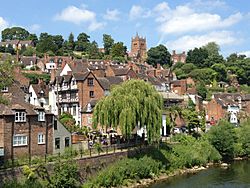 High Town from the River Severn |
|
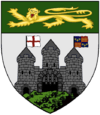 Coat of arms of Bridgnorth Motto: Fidelitas Urbis Salus Regis In the town's loyalty lies the King's safety |
|
| Population | 12,079 (2011) |
| OS grid reference | SO716927 |
| Civil parish |
|
| Unitary authority |
|
| Ceremonial county | |
| Region | |
| Country | England |
| Sovereign state | United Kingdom |
| Post town | BRIDGNORTH |
| Postcode district | WV15, WV16 |
| Dialling code | 01746 |
| Police | West Mercia |
| Fire | Shropshire |
| Ambulance | West Midlands |
| EU Parliament | West Midlands |
| UK Parliament |
|
Bridgnorth is a busy market town in Shropshire, England. It is split into two main parts by the River Severn: High Town and Low Town. High Town sits on the right bank of the river, while Low Town is on the left. In 2011, about 12,079 people lived here.
Contents
History of Bridgnorth
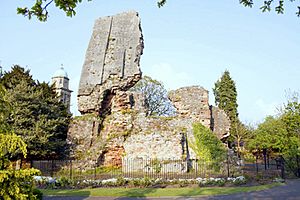
Bridgnorth gets its name from a bridge over the River Severn. This bridge was built further north than an older one at a place called Quatford. The town was first mentioned in history in 895. Back then, the Danes set up a camp nearby.
In 912, Æthelfleda, a powerful Anglo-Saxon queen, built a mound on the west side of the River Severn. This was part of her fight against the Danes. This mound might have been where Bridgnorth Castle stands today. Early names for Bridgnorth, like Brigge and Bruges, all refer to its bridge over the Severn.
After the Normans took over England, King William I gave the land of Bridgnorth to Roger de Montgomerie, 1st Earl of Shrewsbury. The town itself began in 1101. Roger's son, Robert of Bellême, 3rd Earl of Shrewsbury, moved from Quatford. He built a castle and a church where the town is now.
Bridgnorth became a royal town in 1102. The castle was built to protect against attacks from Wales. In 1322, the town was attacked and burned by Roger Mortimer, 1st Earl of March. A small Jewish community lived in the town for a short time in 1267 but left in 1274.
Bridgnorth's town walls were first made of wood between 1216 and 1223. Later, they were rebuilt with stone. By the 1500s, most of the walls were in ruins. Out of five original gates, only one remains today.
During the English Civil War, Bridgnorth was a key stronghold for the King's supporters (Royalists). In 1642, many Royalist soldiers were based there. In 1646, Oliver Cromwell's army, the Roundheads, came to take Bridgnorth. After a three-week siege, Cromwell won. He then ordered the castle to be destroyed.
An ironworks in Low Town built a famous steam locomotive in 1808. It was called Catch Me Who Can and was designed by Richard Trevithick. A special plaque marks this important event.
More than 255 men from Bridgnorth joined the army in the first months of the First World War. Those who died are remembered on the war memorial in the castle grounds.
Until 1961, the Royal Air Force had a training base at RAF Bridgnorth. This base opened in 1939. During the Second World War, two women died in a German air raid in August 1940. Bombs hit houses in High Town. In 2005, some old German papers from 1941 were found. They talked about Operation Sea Lion, which was Nazi Germany's plan to invade Britain. Bridgnorth was mentioned in these papers. Some experts believe Adolf Hitler might have wanted to make Bridgnorth his personal headquarters in Britain. This was because of its central location, rural setting, train links, and nearby airfield.
In 1978, Bridgnorth became a twin town with Thiers in France. In 1992, it also twinned with Schrobenhausen in Germany. On August 21, 2003, Bridgnorth became a Fairtrade Town.
Geography of Bridgnorth
Bridgnorth is in the Severn Valley. The River Severn flows through a narrow valley with many trees. High Town is built on a high piece of land on the west side of the river. The castle was built at the end of this hill, which is called Castle Hill. Low Town is on lower ground right next to the river.
High Town is about 65–68 metres (213–223 feet) above sea level. Low Town is much lower, at 32–33 metres (105 feet). The land in Low Town is flatter but then rises steeply to the east.
The countryside to the east of the river is part of the West Midlands Green Belt. This is an area of protected land.
The town's area also includes nearby places like Danesford, Oldbury, and Quatford.
Famous Landmarks
Bridgnorth has a special funicular railway called the Castle Hill Railway. It connects High Town and Low Town. It is the steepest and only inland funicular railway in England.
In High Town, you can also find Bridgnorth railway station. This is part of the Severn Valley Railway, a heritage line that goes south to Kidderminster.
The ruins of Bridgnorth Castle are still in the town. It was built in 1101. Because of damage during the English Civil War, the castle leans at a 15-degree angle.
High Town has two important Church of England churches. Church of St. Mary Magdalene, Bridgnorth was designed by Thomas Telford in the late 1700s and is still used today. St. Leonard's was rebuilt a long time ago. It is no longer used for regular church services but is used for community events.
Bishop Percy's House on the Cartway was built in 1580. It is a very old building that survived a big fire in 1646. Thomas Percy (Bishop of Dromore), who wrote famous poems, was born here.
Other important buildings include the 17th-century Bridgnorth Town Hall. It is a half-timbered building. The Northgate, an old town gate, now holds the town's museum. Daniel's Mill, a well-known watermill, is a short distance from Bridgnorth along the River Severn.
You can see the remains of an old hermitage from High Town. Locals often call it The Queens Parlor. A local story says a hermit named Ethelred lived there in 925 AD. This might be true, as Bridgnorth was founded in 912 by Alfred the Great's daughter, Ethelfleda.
Education in Bridgnorth
Bridgnorth has several primary schools. These include Castlefields County Primary School, St Mary's and St Leonard's (both Church of England schools), and the Roman Catholic St John's school. There are also Morville and Brown Clee schools nearby.
The town has two secondary schools: Oldbury Wells School and Bridgnorth Endowed School. These schools serve students from Bridgnorth and nearby villages like Alveley and Highley.
Bridgnorth also has a sixth form called Bridgnorth Sixth Form. It is run within Oldbury Wells School.
Culture and Fun
Bridgnorth has a theatre called the Theatre on the Steps. There is also a 1930s cinema, the Majestic. The Northgate Museum has many items about the town's history. It was the first independent museum in Shropshire to be officially recognized. The town also has an orchestra, Bridgnorth Sinfonia, which performs concerts in St Mary's Church.
Sports and Clubs
Bridgnorth Town F.C. was the town's main football club. They won a league championship in 2008. After the club closed, a new one called A.F.C. Bridgnorth took its place.
Bridgnorth Spartans Juniors Football Club has teams for both boys and girls, from young ages up to adults. They play their home games at Oldbury Wells School.
Bridgnorth Rowing Club is located in 'The Maltings' building by Severn Park. The club bought the building in 1983 and turned it into a boathouse. They compete in rowing events and host an annual regatta on the River Severn.
Bridgnorth Army Cadets is the oldest Army Cadet group in Shropshire. The Army Cadet Force (ACF) celebrated 150 years in 2010.
In 2007, Bridgnorth hosted a UK Downhill Street Race for cyclists.
A performing arts school, Stagecoach Kidderminster & Bridgnorth, offers classes for young people aged 6 to 18.
Local Media
You can get local news and TV shows from BBC West Midlands and ITV Central.
Local radio stations include BBC Radio Shropshire, Heart West Midlands, and Severnvalley Radio.
The town's local newspaper is the Shropshire Star.
Getting Around Bridgnorth
Roads
Bridgnorth started as a market town with roads leading to smaller villages. Many of these roads met at the High Street where the town hall is now. The River Severn was once very important for trade, but boats cannot easily travel this far upstream anymore.
Bridgnorth is connected to Shrewsbury and Stourbridge by the A458 road. The A442 road connects it to Telford and Kidderminster. The A454 road goes to Wolverhampton. The town is about 11 miles (18 km) from the M54 motorway near Telford.
The A458 road now goes around the south of the town centre. This bypass was built starting in 1982. It helps reduce traffic in the town centre. The bypass also gave Bridgnorth a second bridge over the Severn. This is the only other way to cross the river besides the old bridge connecting Low and High towns.
Buses
Buses connect Bridgnorth to places like Telford, Shrewsbury, Wolverhampton, Much Wenlock, Ironbridge, Shifnal, and Kidderminster. These services are run by companies like Arriva Midlands and Diamond Bus.
Railway
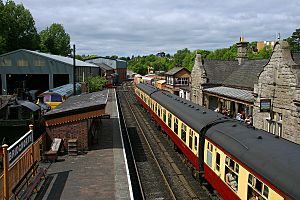
Today, the closest towns with regular train stations are Telford and Wolverhampton. However, Bridgnorth does have a station on a special heritage railway, the Severn Valley Railway.
Bridgnorth station was not the end of this line when it was first built in 1862. It was a main stop between Hartlebury and Shrewsbury. The station closed to passengers in 1963.
The station building is very old and has a special design. This means any future changes to make it better for visitors must match its historic look.
The railway line now ends just north of the station. There is still talk about whether the railway should extend further north from Bridgnorth.
Cliff Railway
The Bridgnorth Cliff Railway is a funicular railway that has been running for over 100 years. It connects the lower part of High Town to the upper part. The bottom entrance is near the River Severn, and the top entrance is near the ruins of Bridgnorth Castle.
It opened on July 7, 1892, with a big celebration. It is one of the steepest railways in the country. Some say it is both the steepest and shortest. It is the only working inland funicular railway in England. There are about 15 more at English seaside towns.
The railway first used water and gravity to move. In 1943–44, it was changed to run on electricity. In 1955, new cars were added that could carry 18 passengers each. These cars are still used today. In April 2024, a return ticket cost £2.00.
The railway makes it easy to travel between the two parts of High Town. Otherwise, you would have to climb 200 steps or take a much longer road. The buildings at the top and bottom of the railway are now used as tea-rooms and guest houses.
The railway was closed for repairs from December 2022 to March 2024 due to damage to a wall.
Walking and Cycling
Bridgnorth is on National Route 45 of the Sustrans National Cycle Network. This route is called the Mercian Way.
A long-distance walking trail called the Geopark Way starts in Bridgnorth.
Every year since 1967, a sponsored walk has been held in Bridgnorth. The Bridgnorth Lions Club has organized it since 2017.
Economy
On the eastern side of the town, there is a large aluminium factory. It was started in the 1950s.
Local Government
The town has a town council with sixteen members. Four members are chosen from each of the four areas (called wards) in the town: Castle, Morfe, East, and West.
Other local services are provided by Shropshire Council. Bridgnorth chooses four of its members for this council.
Famous People from Bridgnorth
People before 1900
- Richard Baxter (1615–1691) was an English religious leader.
- Edward Synge (1621 in Bridgnorth–1678) became a bishop in Ireland.
- Francis Moore (1657–1715) was a doctor and astrologer. He started Old Moore's Almanack.
- Elizabeth Jeffries (1727–1752) was an English woman.
- Thomas Percy (1729–1811) was a bishop in Ireland.
- Mary Martha Sherwood (1775-1851) was a children's author. She lived in Bridgnorth for a few years.
- William Macmichael (1783–1839) was a doctor and writer about medicine.
- Samuel Bache (1804–1876) was an English religious minister.
People after 1900
- Henry Southwell (1860-1937) was a Church of England clergyman who became a bishop.
- Henry Cope Colles (1879 in Bridgnorth–1943) was a music critic.
- Sir Terence O'Connor (1891–1940) was a politician and lawyer.
- John Dudley North (1893–1968) was a chairman and managing director of an aircraft company.
- Katharine St. George (1894 in Bridgnorth–1983) was a US politician and a cousin of President Franklin Delano Roosevelt.
- Thomas Orde Lawder Wilkinson (1894–1916) was a soldier who won a special medal for bravery.
- Elizabeth Dilys Powell (1901–1995) was a journalist, famous as a film critic.
- Air Commodore Cathcart Wight-Boycott (1910–1998) was a fighter pilot during World War 2.
- Ross Antony (born 1974) is a musical actor, singer, and TV entertainer in Germany.
- Peter Bullock (1937–2008) was a scientist who studied soil.
- George Helon (born 1965) is an author and businessman.
- Dominic Sandbrook (born 1974) is a historian, author, and TV presenter.
Sports People
- Richard Colley (1833-1902) was a cricketer.
- Ken Armstrong (born 1959) is a former footballer.
- Trevor Meredith (born 1936) is a footballer, mostly for Shrewsbury Town.
- Gareth Mumford (born 1973) is a cricketer.
- Craig Parnham (born 1973) is a field hockey player and coach. He played for Great Britain in the Olympics.
- David Preece (1963–2007) was a midfield footballer.
- Ashley Westwood (born 1976) is a former footballer and manager.
Twin Towns
Bridgnorth is twinned with:
- Thiers, Puy-de-Dôme, France
- Schrobenhausen, Germany
Nearby Places
 |
Much Wenlock, Shrewsbury | Broseley, Telford, Newport | Albrighton, Wolverhampton |  |
| Church Stretton, Bishop's Castle | Bobbington, Wombourne, Dudley, Birmingham | |||
| Ludlow, Craven Arms | Oldbury, Highley, Chelmarsh, Alveley, Cleobury Mortimer | Enville, Kinver, Stourbridge, Bewdley, Kidderminster |
See also
 In Spanish: Bridgnorth para niños
In Spanish: Bridgnorth para niños


